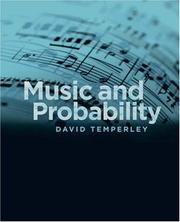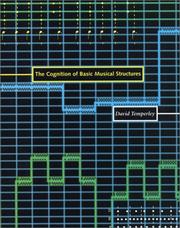| Listing 1 - 4 of 4 |
Sort by
|

ISBN: 1429455373 128209680X 9786612096808 0262257076 0262201666 0262515199 9780262257077 9780262201667 0262293978 9781282096806 9780262515191 9781429455374 9780262293976 6612096802 Year: 2007 Publisher: Cambridge (Mass.) : MIT press,
Abstract | Keywords | Export | Availability | Bookmark
 Loading...
Loading...Choose an application
- Reference Manager
- EndNote
- RefWorks (Direct export to RefWorks)
Exploring the application of Bayesian probabilistic modeling techniques to musical issues, including the perception of key and meter.
Musical perception --- Music and probability. --- Probability and music --- Music --- Probabilities --- Auditory perception --- Mathematical models. --- Mathematics --- Psychological aspects --- Perception musicale --- COMPUTER SCIENCE/Computer Music --- ARTS/Music & Sound Studies --- Probability theory
Book
ISBN: 0262284766 0585445222 9780262284769 9780585445229 Year: 2001 Publisher: Cambridge, Mass. : MIT Press,
Abstract | Keywords | Export | Availability | Bookmark
 Loading...
Loading...Choose an application
- Reference Manager
- EndNote
- RefWorks (Direct export to RefWorks)
In this book, David Temperley addresses a fundamental question about music cognition: how do we extract basic kinds of musical information, such as meter, phrase structure, counterpoint, pitch spelling, harmony, and key from music as we hear it? Taking a computational approach, Temperley develops models for generating these aspects of musical structure. The models he proposes are based on preference rules, which are criteria for evaluating a possible structural analysis of a piece of music. A preference rule system evaluates many possible interpretations and chooses the one that best satisfies the rules. After an introductory chapter, Temperley presents preference rule systems for generating six basic kinds of musical structure: meter, phrase structure, contrapuntal structure, harmony, and key, as well as pitch spelling (the labeling of pitch events with spellings such as A flat or G sharp). He suggests that preference rule systems not only show how musical structures are inferred, but also shed light on other aspects of music. He substantiates this claim with discussions of musical ambiguity, retrospective revision, expectation, and music outside the Western canon (rock and traditional African music). He proposes a framework for the description of musical styles based on preference rule systems and explores the relevance of preference rule systems to higher-level aspects of music, such as musical schemata, narrative and drama, and musical tension [Publisher description].
Music theory --- Musical perception --- Théorie musicale --- Perception de la musique --- Music --- Music, Dance, Drama & Film --- Music Instruction & Study --- Auditory perception --- Musical theory --- Theory of music --- Data processing. --- Computer simulation. --- Informatique. --- Simulation par ordinateur. --- Data processing --- Computer simulation --- Psychological aspects --- Theory
Book
ISBN: 9780190870522 9780190653774 Year: 2018 Publisher: Oxford Oxford University press
Abstract | Keywords | Export | Availability | Bookmark
 Loading...
Loading...Choose an application
- Reference Manager
- EndNote
- RefWorks (Direct export to RefWorks)
In all of the books about rock music, relatively few focus on the purely musical dimensions of the style: dimensions of harmony and melody, tonality and scale, rhythm and meter, phrase structure and form, and emotional expression. The Musical Language of Rock puts forth a new, comprehensive theoretical framework for the study of rock music by addressing each of these aspects. Eastman music theorist and cognition researcher David Temperley brings together a conventional music-analytic approach with statistical corpus analysis to offer an innovative and insightful approach to the genre. With examples from across a broadly defined rock idiom encompassing everything from the Beatles to Deep Purple, Michael Jackson to Bonnie Raitt, The Musical Language of Rock shows how rock musicians exploit musical parameters to achieve aesthetic and expressive goals-for example, the manipulation of expectation and surprise, the communication of such oppositions as continuity/closure and tension/relaxation, and the expression of emotional states. A major innovation of the book is a three-dimensional model of musical expression-representing valence, energy, and tension-which proves to be a powerful tool for characterizing songs and also for tracing expressive shifts within them. The book includes many musical examples, with sound clips available on the book's website. The Musical Language of Rock presents new insights on the powerful musical mechanisms which have made rock a hallmark of our contemporary musical landscape

ISBN: 0262201348 Year: 2001 Publisher: Cambridge (Massachusetts) MIT Press
Abstract | Keywords | Export | Availability | Bookmark
 Loading...
Loading...Choose an application
- Reference Manager
- EndNote
- RefWorks (Direct export to RefWorks)
In this book, David Temperley addresses a fundamental question about music cognition: how do we extract basic kinds of musical information, such as meter, phrase structure, counterpoint, pitch spelling, harmony, and key from music as we hear it? Taking a computational approach, Temperley develops models for generating these aspects of musical structure. The models he proposes are based on preference rules, which are criteria for evaluating a possible structural analysis of a piece of music. A preference rule system evaluates many possible interpretations and chooses the one that best satisfies the rules. After an introductory chapter, Temperley presents preference rule systems for generating six basic kinds of musical structure: meter, phrase structure, contrapuntal structure, harmony, and key, as well as pitch spelling (the labeling of pitch events with spellings such as A flat or G sharp). He suggests that preference rule systems not only show how musical structures are inferred, but also shed light on other aspects of music. He substantiates this claim with discussions of musical ambiguity, retrospective revision, expectation, and music outside the Western canon (rock and traditional African music). He proposes a framework for the description of musical styles based on preference rule systems and explores the relevance of preference rule systems to higher-level aspects of music, such as musical schemata, narrative and drama, and musical tension [Publisher description].
#PBIB:2003.2 --- muziektheorie --- Music --- dataprocessing --- computersimulaties --- Artificial intelligence. Robotics. Simulation. Graphics --- Affective and dynamic functions --- Music theory --- Musical perception --- Théorie musicale --- Perception musicale --- Theory --- Data processing --- Computer simulation --- Music theory - Data processing. --- Musical perception - Computer simulation. --- Musical theory --- Theory of music --- Auditory perception --- Psychological aspects
| Listing 1 - 4 of 4 |
Sort by
|

 Search
Search Feedback
Feedback About UniCat
About UniCat  Help
Help News
News